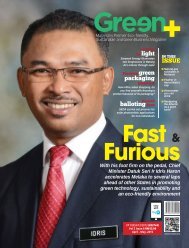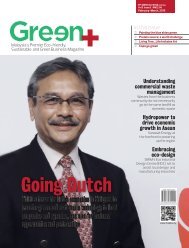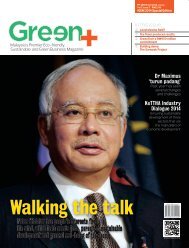Green+ Malaysia's Premier Eco-friendly, Sustainable and Green Business Magazine
SIRIM - Technology Provider
SIRIM - Technology Provider
You also want an ePaper? Increase the reach of your titles
YUMPU automatically turns print PDFs into web optimized ePapers that Google loves.
COLUMN<br />
in the transition towards a low-carbon<br />
<strong>and</strong> resource-efficient economy that<br />
will reshape the labour market <strong>and</strong><br />
open new opportunities for job growth.<br />
Malaysia’s outlook towards 2020 for<br />
renewable energy is expected to create<br />
RM70 billion <strong>and</strong> support in upwards<br />
of 50,000 jobs while reducing carbon<br />
emissions by 40%.<br />
The commitment to achieving<br />
these targets looms large as globally,<br />
the relationship between sustainable<br />
development, green growth <strong>and</strong> good<br />
labor market performance, while not<br />
automatic, are mutually reinforcing.<br />
Investing in renewable energy, waste<br />
management, sustainable forestry,<br />
green technology <strong>and</strong> sustainable business<br />
practices can serve as economic<br />
drivers, stimulate job creation <strong>and</strong><br />
national development while mitigating<br />
environmental <strong>and</strong> social challenges.<br />
The second, <strong>and</strong> what I believe is<br />
the most critical of the two, exists on<br />
a fundamental level <strong>and</strong> must become<br />
part of the cultural l<strong>and</strong>scape for business<br />
nationally: sustainable business<br />
practices.<br />
In order for Malaysia to become a<br />
fully developed <strong>and</strong> high-income nation,<br />
national corporations must invest in<br />
their greatest asset, their workforce.<br />
They must also look across its borders<br />
at sustainability leaders among counterparts<br />
from other nations, set goals<br />
<strong>and</strong> be determined to raise the bar<br />
locally. The number of organizations<br />
that practice sustainability reporting<br />
through the Global Reporting Initiative<br />
(GRI) needs to increase, as well as the<br />
participation in the UN Global Compact<br />
by Malaysian CEOs. This establishes ties<br />
to global entities that drive sustainable<br />
development directly <strong>and</strong> naturally<br />
elevate Malaysia’s status among developed<br />
nations.<br />
The additional benefits of having<br />
a national increase in sustainability<br />
reporting will be realized in greater<br />
agility in planning, monitoring, <strong>and</strong><br />
evaluating the effectiveness of national<br />
policies, as well as establishing a firm<br />
trajectory up the global value chain. For<br />
the corporations, through compare<strong>and</strong>-contrast<br />
activities, they will<br />
establish market differentiation <strong>and</strong><br />
investor <strong>and</strong> shareholder confidence<br />
while increasing organizational<br />
maturation.<br />
There is a quote that has been popping<br />
up on social media that depicts a<br />
CEO <strong>and</strong> CFO holding a conversation<br />
where the CEO asks, “What happens<br />
if we train our employees <strong>and</strong> they<br />
leave?” The CFO responds, “What happens<br />
if we don’t <strong>and</strong> they stay?” This is<br />
a great message about investing in your<br />
best assets: your workforce.<br />
To develop OCC, organizations must first have<br />
the organizational structure in place that<br />
encourages a systems approach to thinking by<br />
breaking the rigid silo approach <strong>and</strong> therefore<br />
has the entire organization in mind <strong>and</strong> the<br />
buy-in from all levels when making critical<br />
decisions.<br />
Further establishing organizational<br />
capacity for change requires continuous<br />
improvement <strong>and</strong> repeatedly asking these<br />
questions:<br />
Where are we? – Do we have a benchmark<br />
that outlines how our organizational systems<br />
approach change initiatives, <strong>and</strong> are they<br />
sustainable?<br />
What is working <strong>and</strong> what is not working?<br />
– This is self-explanatory, but oftentimes,<br />
organizations that operate in silo capacities<br />
do not have the objectivity to look inward <strong>and</strong><br />
change what is holding them back.<br />
Where do we want to be? – Set a clear target<br />
for productivity <strong>and</strong> sustainability. The two go<br />
h<strong>and</strong> in h<strong>and</strong>.<br />
What do we need to change, <strong>and</strong> what are<br />
the key priorities? - Establish a roadmap that<br />
includes short- <strong>and</strong> long-term goals, as well as<br />
An even more powerful message<br />
could read, “What happens if we invest<br />
in our employees, <strong>and</strong> we are not change<br />
ready <strong>and</strong> therefore can’t benefit?” or,<br />
“Why are we investing in training our<br />
employees in areas that are not relevant<br />
or a priority for our organization right<br />
now?”<br />
In a 2013 a survey of 1000 CEOs was<br />
conducted by Accenture <strong>and</strong> the United<br />
Nations Global Compact that spanned<br />
27 industries in 103 countries, 93%<br />
regarded sustainability as a new key for<br />
business success.<br />
These outcomes indicate that there<br />
is little argument that organizations<br />
are realizing that they must become<br />
more sustainable <strong>and</strong> “get in shape,”<br />
the question that is most commonly<br />
asked is “how?” The key lies in aligning<br />
organizational priorities to strategy <strong>and</strong><br />
expectations. Growing towards a sustainable<br />
model requires organizational<br />
capacity for change (OCC).<br />
quick wins.<br />
How will we get there? – Work with a third<br />
party to assist in performing an assessment<br />
with health checks.<br />
How will we know we are there? - Establish<br />
key performance indicators (KPI) <strong>and</strong> a level to<br />
achieve against an international rating system.<br />
Periodic health checks using external<br />
evaluation systems such as the GPM® PSM3<br />
Sustainability Assessment Model supports<br />
organizations in building the capacity to<br />
make the right decisions. In order to achieve<br />
the benefits that drive an organization<br />
upward, it can leverage what works well across<br />
the enterprise <strong>and</strong> establish key metrics that<br />
the organization can measure, manage, <strong>and</strong><br />
ultimately achieve.<br />
The developed nations of the world are fast<br />
realizing the gains by investing in sustainability<br />
<strong>and</strong> with Asean Free Trade Agreement (Afta)<br />
coming into full effect in 2015, Malaysia can<br />
capitalize by increasing its collective capacity<br />
for change by investing in the assets that are<br />
already in place, emphasizing a culture of<br />
innovation. This will transform potential into<br />
momentum <strong>and</strong> reality.<br />
green+.2014, november-december 27





